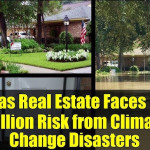Over $1.1 trillion in Texas real estate is at risk from floods, wildfires, and extreme weather. Discover what this means for homeowners, buyers, and investors.
Texas is known for big skies, booming cities, and wide-open opportunities. But now it’s making headlines for something far less appealing: over $1.1 trillion worth of Texas real estate is at risk from extreme weather events like floods, hurricanes, and wildfires.
This staggering figure comes as climate change intensifies storms, raises temperatures, and increases the unpredictability of natural disasters. And Texas isn’t alone—across the U.S., nearly $12 trillion in property faces similar threats.
Table of contents [Show]
Why Texas Is in the Hot Zone
Several factors make the Lone Star State particularly vulnerable:
Hurricanes and Flooding – Coastal cities like Houston and Galveston face recurring storm surges and heavy rain.
Extreme Heat and Drought – Longer summers mean higher wildfire risks and strain on infrastructure.
Urban Growth in Risk Zones – Rapid development has placed millions of homes in areas exposed to flooding and fire hazards.
What This Means for Homeowners
If you own property in Texas, the risks aren’t just environmental—they’re financial. Rising insurance premiums, stricter building codes, and declining property values could all reshape the real estate market in the coming years. Some insurers have already scaled back coverage in high-risk areas, leaving homeowners scrambling for alternatives.
How to Protect Your Property Investment
Here are a few smart moves for Texans (and anyone living in climate-vulnerable areas):
Check Your Flood and Fire Risk – Tools like FEMA maps or private climate risk assessments can give you clarity.
Review Your Insurance Policy – Make sure your coverage actually protects against floods, storms, or wildfires.
Upgrade Your Home – Elevating structures, reinforcing roofs, or using fire-resistant materials can reduce risks and sometimes lower premiums.
Think Long-Term – When buying property, consider climate resilience alongside location and price.
The Bigger Picture
The Texas story is a warning sign for the entire U.S. real estate market. With billions of dollars in assets on the line, climate change is no longer just an environmental issue—it’s an economic one. Investors, homeowners, and policymakers will need to rethink where and how communities grow in the decades ahead.
Final Thought
Texas has always been a place of resilience and reinvention. But with $1.1 trillion in real estate at risk, the state faces a defining challenge. Whether you’re a homeowner, buyer, or investor, the message is clear: in 2025 and beyond, climate risk is real estate risk.















